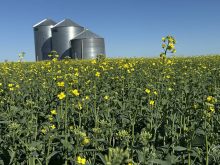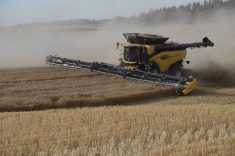KLEEFELD, Man. – For the past few years Hannes and Nicole Maurer have been running a pig production experiment, though they never planned it that way.
They have been simultaneously operating a traditional hog barn and five fabric-covered shelters, with each side of the operation handling about half of their 2,000 feeder pigs.
There are great management differences between the two systems, but surprisingly little difference on the bottom line.
“Both systems are working well,” Hannes said on a hot, sunny summer day as his pigs in the shelters grunted, squealed and generally sounded happy in their straw homes. Nothing could be heard from the nearby barn.
Read Also

VIDEO: Catch up with the Western Producer Markets Desk
The Western Producer Markets Desk provides daily updates on agricultural markets, with recent video commentary including looks into canola, wheat, cattle and feed grains.
“I can live with either,” he said.
The Maurers built the fabric-roofed shelters because they wanted to double their production, but didn’t want to add on to the barn. It wasn’t a political statement or a vote against the efficiency of barn production. The Maurers weren’t sure about the hog industry’s future at the time and didn’t want to invest heavily in an industry they might not be part of in 10 years.
The shelters, hoop-roofed structures with concrete floors and open ends, didn’t require as big an investment.
Cost of production is a tricky thing to work out when comparing the two systems, Maurer said. The shelter is much cheaper to build, so there is less capital tied up and less interest burden than with a barn.
But over time Hannes thinks the barn’s superior growth efficiency will equal and then surpass the shelter’s performance, probably in six to eight years.
The Maurers’ shelter system uses straw for both bedding and to hold manure. The pigs are moved to a different shelter every few weeks so that the soiled straw can be removed.
The straw is piled in a long ridge in a local field, where it semi-composts and is eventually distributed onto the fields as dry manure.
Maurer said there is a substantial straw cost per pig. The per pig cost is about $3 if large bales costs $10 each to produce or buy and bring to the yard.
Manure spreading costs about $2.50 per pig and transportation to the field costs about $1.50.
Barn costs are lower, at about $1.50 per pig for lagoon storage. The difference between barn production and shelter production is about $5.50 per pig, Hannes reckoned.
With about three batches of feeders going through every year, that equals about $15 per pig more in a shelter.
Outdoor pigs also grow slower, Maurer said.
In the summer there isn’t much difference, just perhaps two or three days.
In the coldest winter there is more impact, with outdoor pigs taking up to 10 days longer to hit market weight.
He chalks up the difference to the rigorous conditions in the winter and pigs eating some straw instead of all the feed in the summer.
But altogether, Maurer didn’t think the slightly longer production time mattered.
“Two or three days is not a very, very long time in a 100-day-to-market system.”
Maurer said pig management is easier in the barn, where the animals are kept in smaller enclosures. For example, a sick pig can be better segregated and treated in a barn with small pens than they can in an open shelter.
Cleaning the shelters and hauling straw to them is also more work.
But the higher per pig production cost in the shelter can still seem a better option if the shelters’ capital cost is written down over a longer period of time.
The composted manure has also helped improve the soil quality of his and his neighbours’ fields.
Carcass quality is no different.
Maurer said he would probably build a large, enclosed barn if he had lots of money and was willing to make a long-term investment.
But with the instability in the hog industry and uncertainty over the role of the small producer, Maurer said he feels better having less capital tied up in his facilities.
“This works,” he said about his hybrid operation.















